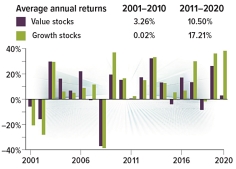Growth stocks have dominated the market for the last decade, led by tech giants and other fast-growing companies. While it’s possible this trend may continue, some analysts think that value stocks may have strong appeal during the economic recovery.1
No one can predict the market, of course. And past results are never a guarantee of future performance. But it may be helpful to consider these two types of stocks and the place they hold in your portfolio.
Value stocks are associated with companies that appear to be undervalued by the market or are in an industry that is currently out of favor. These stocks may be priced lower than might be expected in relation to their earnings, assets, or growth potential. In an expensive market, value stocks can offer bargains.
Established companies are more likely than younger companies to be considered value stocks. Older businesses may be more conservative with spending and emphasize paying dividends over reinvesting profits. The potential for solid dividend returns regardless of market direction is one reason why value stocks can be appealing, especially in the current low-interest environment. An investor who purchases a value stock typically expects the broader market to eventually recognize the company’s full potential, which might push the stock price upward. One risk is that a stock may be undervalued for reasons that cannot be easily remedied, such as legal difficulties, poor management, or tough competition.
Growth stocks are associated with companies that appear to have above-average growth potential. These companies may be on the verge of a market breakthrough or acquisition, or they might occupy a strong position in a growing industry. The dominance of large technology stocks over the last few years is one example of this.
Growth companies may be more aggressive with spending and place more emphasis on reinvesting profits than paying dividends (although many larger growth companies do offer dividends). Investors generally hope to benefit from future capital appreciation. Growth stocks may be priced higher in relation to current earnings or assets, so investors are essentially paying a premium for growth potential. This is one reason why growth stocks are typically considered to carry higher risk than value stocks.
Diversification and Weighting
Value and growth stocks tend to perform differently under different market conditions (see chart). For diversification, it may be wise to hold both value and growth stocks in your portfolio, but this can be accomplished by investing in broad index funds, which generally include a mix of value and growth stocks. These are considered blended funds.

Typically, investors who follow a value or growth strategy weight their portfolios to one side or the other through funds or individual stocks. If you use a mutual fund or exchange traded fund (ETF) to emphasize value or growth in your equity portfolio, it’s important to understand the fund’s objectives and structure, including the index that the fund uses as a benchmark.
Diversification is a method used to help manage investment risk; it does not guarantee a profit or protect against loss. The return and principal value of stocks, mutual funds, and ETFs fluctuate with changes in market conditions. Shares, when sold, may be worth more or less than their original cost. The amount of a company’s dividend can fluctuate with earnings, which are influenced by economic, market, and political events. Dividends are typically not guaranteed and could be changed or eliminated.
Mutual funds and ETFs are sold by prospectus. Please consider the investment objectives, risks, charges, and expenses carefully before investing. The prospectus, which contains this and other information about the investment company, can be obtained from your financial professional. Be sure to read the prospectus carefully before deciding whether to invest.
